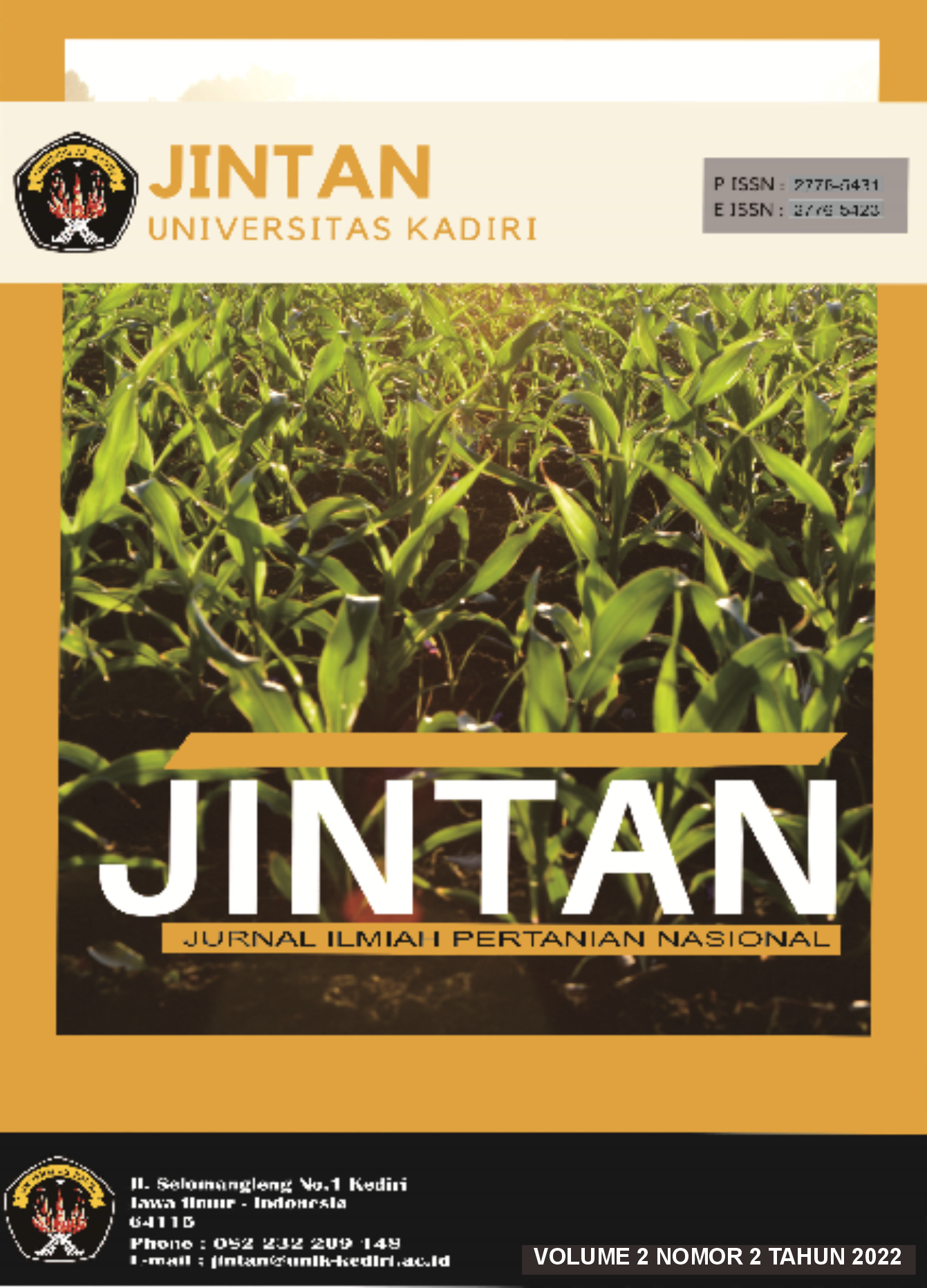Perbandingan Penghasilan Antara Petani Tembakau Rajang Serta Padi Sebagai Tanaman Rotasi di Dusun Krajan Desa Gesikan Kecamatan Gondang Kabupaten Tulungagung
DOI:
https://doi.org/10.30737/jintan.v2i2.2747Keywords:
Income analysis, Tobacco Chopping, Rice FarmingAbstract
Along with household needs, farmers are required to have additional income. One way to overcome the income constraints is through a crop rotation system. Chopped tobacco and rice are crops that can be rotated. These two crops have been planted by farmers in the Krajan Hamlet, Gesikan Village, TuIungagung Regency. This study aimed to determine the costs and revenues of crop rotation farming of chopped tobacco and rice in the location. The sampling method used in this research was the census. Based on the survey results and these criteria, the total number of farmers was 25 people. Meanwhile, the types of data used in this research were primary and secondary data. The analytical methods used included cost, revenue, and income analysis. Comparative analysis of income using t-test. The results of the research showed that the total average production cost of tobacco farming was IDR48,840,304/ha, which was greater than the production cost of rice farming, which was IDR25,334,347, while the average total revenue for tobacco farming was IDR 80,550,000/ha. Meanwhile, the income of rice farming was IDR33.237.000/ha and the average income from tobacco farming was IDR31.709.696/ha. The result of hypothesis testing shows that the t-count value was 1.697260887, which was less than t-table 15.95651376. Therefore, the income from tobacco farming was higher than the income from rice farming statistically.
References
Asri, A. C., Sutanto, A., & Ruslanjari, D. (2012). Studi Komparatif Pendapatan Petani Semangka Dan Petani Padi (Studi Kasus Desa Pilang Dan Desa Sidodadi Kecamatan Masaran Kabupaten Sragen). Bumi Indonesia, 1(3).
Badan Pusat Statistika Provinsi Jawa Timur. (2020). Analisis Data Tembakau Provinsi Jawa Timur 2019.
Bayu Oktavianto, H. R. (2017). ANALISIS KOMPARATIF USAHATANI PADI LADANG DAN JAGUNG DI DESA TANJUNG SARI KECAMATAN BLAMBANGAN UMPU KABUPATEN WAY KANAN. JASEP, 3(2).
Dwi Priyatno. (2010). Paham Analisa Statistik Data Dengan SPSS (8th ed.). Mediaakom.
Lubis, S. K. (2020). Analisis Perbandingan Pendapatan Usahatani Tumpangsari Jagung dan Kacang Tanah dengan Monokultur Jagung di Kecamatan Ponjong Kabupaten Gunungkidul. Ustjogja, 3–13.
Nurul Aini, Abdullah Usman, Ig. L. P. T. (2018). Analisis Komparatif Usahatani Monokultur Tembakau Rakyat dan Tumpangsari Tembakau Rakyat dengan Cabai di Kecamatan Pringgabaya Kabupaten Lombok Timur. Agroteksos, 28(3), 1–11.
Nuryanti, D. M., & Kasim, N. N. (2017). Analisis Pendapatan Usahatani Pola Rotasi Tanaman Padi-Jagung Manis Di Desa Mulyasari Kecamatan Sukamaju. Journal TABARO, 1(2), 95–104.
Raihan Aulia, Anwar Deli, S. K. (2020). ANALISIS KOMPARASI PENDAPATAN KOMODITI KAKAO DAN KELAPA SAWIT DI KECAMATAN KLUET UTARA KABUPATEN ACEH SELATAN. Jurnal Ilmiah Mahasiswa Pertanian, 5(2009), 77–87.
Sandiani, N. K. (2014). ANALISIS KOMPARATIF PENDAPATAN USAHATANI PADI SAWAH SISTEM TANAM JAJAR LEGOWO 2:1 DAN 4:1 DI DESA PUNTARI MAKMUR KECAMATAN WITAPONDA. Agrotekbis, 2 (2)(April), 199–204.
Soekartawi. (1995). Analisis Usahatani. Universitas Indonesia Press, Jakarta. Gramedia Pustaka Utama, Jakarta.
Soekartawi. (2003). Prinsip Ekonomi Pertanian. Rajawali Press. Jakarta.
Sugiyono. (2018). Metode Peneiltian Kuantitatif, Kualitatif dan R&D. In Alfabeta Bandung.
Supardi U.S. (2013). Aplikasi Statistika Dalam Penelitian : Konsep Statistika Yang Lebih Komperehensif. Change Publication.
Suwarto, Y. O. (2010). Budidaya 12 Tanaman Perkebunan Unggulan. Penebar Swadaya.
Umikalsum, R. A. (2018). Analisis Pendapatan Usahatani Pola Tanam Padi-Jagung di Desa Suka Damai Kecamatan Tanjung Lago Kabupaten Banyuasin. Societa, 7(2), 158–164.
Downloads
Published
How to Cite
Issue
Section
License
Authors who publish in this journal agree to the following terms:
- Authors retain copyright and grant the journal right of first publication with the work simultaneously licensed under a Creative Commons Attribution License (https://creativecommons.org/licenses/by-nc-nd/4.0/) that allows others to share the work with an acknowledgment of the work's authorship and initial publication in this journal. Permitted third party reuse is defined by the Creative Commons Attribution-NonCommercial-NoDerivs (CC BY-NC-ND). This permission allows users to copy and distribute the Article, provided this is not done for commercial purposes and further does not permit distribution of the Article if it is changed or edited in any way, and provided the user gives appropriate credit (with a link to the formal publication through the relevant DOI), provides a link to the license, and that the licensor is not represented as endorsing the use made of the work.
- Authors are able to enter into separate, additional contractual arrangements for the non-exclusive distribution of the journal's published version of the work (e.g., post it to an institutional repository or publish it in a book), with an acknowledgment of its initial publication in this journal.
- Authors are permitted and encouraged to post their work online (e.g., in institutional repositories or on their website) prior to and during the submission process, as it can lead to productive exchanges, as well as earlier and greater citation of published work.
- For open-access publishing, authors have the right to share their articles in the same ways permitted to third parties under the relevant user license, as well as certain scholarly usage rights.




